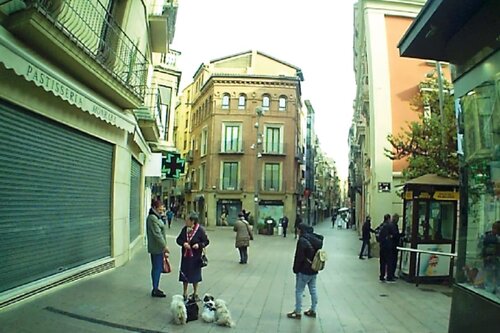Narrow streets are more stressful for women and open spaces are more stressful for men
According to research carried out by the UdL and IRBLleida in the Historic Centre using heart rate and subjective assessments
Women tend to have higher levels of stress in narrow pedestrian streets with the presence of other people and men in open spaces, as a result of urban morphology and their own perception of safety. This has been verified by research carried out by the University of Lleida (UdL) and the Biomedical Research Institute of Lleida (IRBLleida) in the historic centre of the capital of the Segrià region, which has been published in the journal Cities. The study analyses to what extent the emotions identified after an event coincide with those experienced in situ, measuring heart rate variability. The researchers say the system can help identify emotionally problematic places to improve the design of public spaces and make cities more friendly.
The research has analysed the feeling of fear generated in certain public spaces in the city, based on heart rate and descriptions of the participants' experiences through mind maps and short written summaries. The field study involved 39 women and 31 men, aged between 19 and 24, who walked 3.1 kilometres through the old quarter. They wore sunglasses equipped with cameras, microphones and USB flash drives. They also carried a heart rate sensor and an Android smartphone, which had been prepared specifically for this purpose. The objective data collected by these devices were completed with a self-assessment questionnaire at four points along the route: Plaça del Depòsit, Carrer Compania, Santa Cecília park and the Eix Comercial.
The results show that women experienced a 17.34% higher level of stress than men throughout the entire route. 20.51% of the girls rated it as "unpleasant" compared to 8.6% of the boys, 38.71% of whom rated the experience as "pleasant". The nervousness of 46.24% of the men was extremely low, compared to 22.22% of the women. The highest level of nervousness among women was found in the area around Carrer Companía and the lowest in Santa Cecília park, a green, open space. Curiously, this landscaped area is the one that generates the most stress for men, along with the shopping area. When it came to identifying the emotions experienced along the route, the study found that women tend to express fear and sadness more easily than men. Men, on the other hand, tend to express happiness and anger more easily.
"Since the COVID-19 pandemic, we have seen an exponential increase in panic attacks and fear of going out in the street. Studies like this one allow us to go further and improve the design of public spaces by incorporating criteria related to the well-being and mental health of the population, especially groups such as women and young people," explains Teresa Guilera, researcher at IRBLleida and psychiatrist at the University Hospital Santa Maria de Lleida.
"Real-time data collection complements mental maps based on memories of personal experiences. It is a methodology that can be applied in multiple urban contexts and that allows us to identify spaces that generate negative emotions in citizens," say Montse Guerrero and Daniel Paül, researchers from the Department of Geography and Sociology at the UdL. "This greater tendency of women to experience fear of public space should make us reflect on the effectiveness of our gender equality policies in relation to public spaces", he adds. Among the measures they propose are, for example, avoiding constructions that create long wall areas without any openings or spaces with limited visibility.
The research has been financed with funds from the Institute for Social and Territorial Development (*INDEST) of the University of Lleida. The article also proposes as future lines of research to focus on other gender identities; to analyse other groups, such as the elderly and people of different origins; or to work on other emotions, such as sadness, anger or happiness "to improve our knowledge of the emotions that urban spaces generate in people".
Article: Paül i Agustí D, Guilera T, Guerrero Lladós M. Gender differences between the emotions experienced and those identified in an urban space, based on heart rate variability. Cities, 2022,104000, ISSN 0264-2751, https://doi.org/10.1016/j.cities.2022.104000.
Text: Communication and Press UdL

Subjective view of the Eix from the participants' glasses / Image: Jose Lasala-UdL






